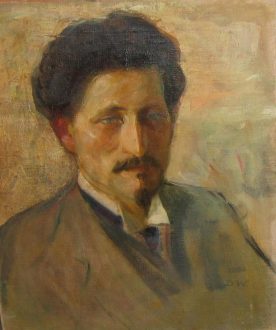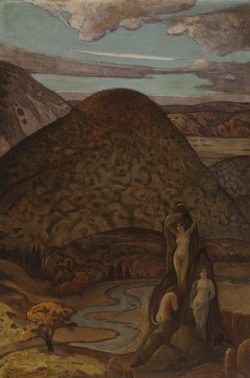David Wallin, Carl E. Wallin, 1914, location unknown (www.wikipedia.com)

Carl E. Wallin 1879–1968
Carl Efraim Wallin was the son of a farmer and carpenter in the village of Vårby, southwest of Stockholm, Sweden, and a younger brother of prominent artist David Wallin, who made his career in Sweden and in Paris. Carl was apprenticed to a painter, served in an artillery regiment, and then emigrated to the U.S. in 1902 at the age of 23. In Denver, he attended Reed’s Art School before moving to Chicago to study at the Art Institute of Chicago, beginning in 1905 and continuing intermittently until 1909. Wallin became a naturalized U.S. citizen in 1910. He lived on Chicago’s far South Side in the Chatham neighborhood, which developed quickly after World War I with an influx of Irish, Hungarian, and Swedish immigrants. In 1920 Wallin went to England and to Sweden, probably on the occasion of a Swedish-American art exhibition that traveled to Stockholm and in which he was represented. He returned to his native land for at least one additional trip, in 1953.
For much of his career Wallin supported himself as a painting contractor while creating portraits, landscapes, and fantasy images. He also executed at least one mural, for a local church, likely in the 1930s. Wallin exhibited sporadically in the Art Institute’s annual “Chicago and Vicinity” exhibitions between 1910 and 1939 and in the museum’s prestigious American art annual twice, in 1924 and 1926. He also showed at the Chicago Galleries Association, where his work was featured in a three-person exhibition in 1935, and in the 1932 No-Jury Society of Artists exhibition in Chicago. Wallin was most active, however, in local exhibitions for Swedish-American artists. Beginning in 1913 and continuing almost to the end of his life, he contributed paintings to the regular shows at the Swedish Club of Chicago, winning several awards. In addition to participating in Swedish-American exhibitions in Sweden in 1920 and 1923, he was included in an exhibition of religious art by Chicago artists held at the Renaissance Society in 1931, and one of his paintings found its way into the collection of the Swedish institution Riksföreningen Sverigekontakt from a 1929 exhibition at the Illinois Women’s Athletic Club in Chicago organized by the Swedish American Art Association, of which he was a member. Apparently Wallin’s only participation in an American exhibition outside Chicago came in 1932, when he was represented in the annual exhibition at the Pennsylvania Academy of the Fine Arts in Philadelphia.
Wallin won the notice of critics from the mid-1920s to the mid-1930s with imaginative fantasy landscapes in which figures are incorporated into natural features such as clouds and landforms, as in The Spirit of Alleghany. A South Side newspaper remarked on the contrast between the quiet, conservative demeanor of the artist and the “fantastic unreality” of his paintings, while Chicago Tribune critic Eleanor Jewett noted of his 1935 show: “Many of his paintings are beautiful, some are merely odd. Nearly all possess charm.”i Notwithstanding such notice, by the late 1930s Wallin apparently abandoned imaginative imagery for conventional portraits and bucolic landscapes, often picturing snow scenes. The latter represented the artist in the Navy Pier annual shows of 1957 and 1958, presumably his last exhibitions, when Wallin was in his 70s.
Wendy Greenhouse, PhD
i “Fantasy Has Its Rewards in Art Show,” Southtown Economist, Feb. 24, 1933; Eleanor Jewett, “Art Notes,” Chicago Tribune, Mar. 31, 1935.
